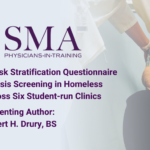Abstract | May 5, 2021
Validation of a Risk Stratification Questionnaire for Tuberculosis Screening in Homeless Patients Across Six Student-run Clinics
Learning Objectives
- Consider the efficacy of screening questionnaires in identifying homeless patients with increased risk of tuberculosis;
- Implement a validated risk stratification questionnaire to aid in preserving tuberculin screening tests for patients at increased risk of tuberculosis.
Background:
Student-run clinics (SRCs) significantly aid in screening homeless patients for tuberculosis. However, with budgets dependent on limited grant funding, administration of tuberculin skin tests (TSTs) to patients with increased risk of tuberculosis may be necessary. Tulane University School of Medicine Tuberculosis Program (TSOM-TB) utilizes an evidence-based risk stratification questionnaire to categorize patients based on their risk for a positive TST. This questionnaire categorizes patients as “low-,” “intermediate-,” or “high-risk” based on a cumulative numerical score calculated from their active symptoms of and risk factors for tuberculosis.
Goal:
To validate if TSOM-TB questionnaire can identify homeless patients at increased risk of a positive TST.
Methods:
A retrospective, multisite chart review of patients screened via TSOM-TB at 6 SRCs between January 2017 through October 2019 was performed. Relative risks (RR) of a positive TST were calculated for those stratified as “low-,” “intermediate-,” or “high-risk.”
Results:
Over 33 months, 6,198 patients at homeless shelters were seen in SRCs. Of those patients, 238 received 30-day clearances without the placement of TST due to “low-risk” stratification and <30 day period of stay. Of the 4,155 patients who received TST and attended their follow-up appointments, 2,254 (54%) were “low-risk” with>30 day period of stay, 1,825 (44%) were “intermediate-risk,” and 76 (2%) were “high-risk.” Compared to “low- risk” patients, “intermediate-risk” patients were more likely to have a positive TST (RR 1.32, confidence interval (CI) 1.01-1.72, p=0.04). This association was not seen with “high-risk” patients. Additional analysis revealed that, compared to patients with no risk factors, patients with 1-2 total risk factors (RR 1.47, CI 1.12-1.93, p=0.006) and 3-5 total risk factors (RR 2.21, CI 1.29-3.79, p=0.004) had an increased risk of a positive TST. This trend was not seen for those with 6-8 total risk factors.
Conclusion:
The TSOM-TB questionnaire was modestly effective at identifying homeless patients with increased risk of a positive TST. Implementation of the TSOM-TB questionnaire may aid SRCs in the preservation of TSTs for those at increased risk of tuberculosis.

